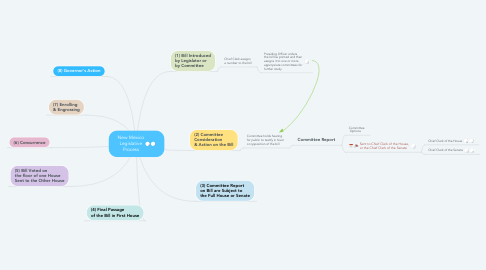
1. (1) Bill Introduced by Legislator or by Committee
1.1. Chief Clerk assigns a number to the bill
1.1.1. Presiding Officer orders the bill be printed and then assigns it to one or more appropriate committees for further study
2. (2) Committee Consideration & Action on the Bill
2.1. Committee holds hearing for public to testify in favor or opposition of the bill
2.1.1. Committee Report
2.1.1.1. Committee Options
2.1.1.1.1. DO PASS
2.1.1.1.2. DO PASS as AMENDED
2.1.1.1.3. DO NOT PASS
2.1.1.1.4. REFER BACK TO FLOOR WITHOUT RECOMMENDATION
2.1.1.1.5. REFER TO ANOTHER COMMITTEE WITHOUT RECOMMENDATION
2.1.1.1.6. SUBSTITUTE A NEW AND SIMILAR BILL INCORPORATING CHANGES THE COMMITTEE MAY WISH TO MAKE
2.1.1.1.7. DO NOTHING AND LET THE BILL DIE BY NOT REPORTING IT OUT COMMITTEE
2.1.1.2. Sent to Chief Clerk of the House, or the Chief Clerk of the Senate
2.1.1.2.1. Chief Clerk of the House
2.1.1.2.2. Chief Clerk of the Senate
3. (3) Committee Report on Bill are Subject to the Full House or Senate
3.1. Not just committees now!
3.2. If the full House or Senate ("The Floor") adopts the bill the bill is PLACED ON THE CALENDAR
3.3. The "CALENDAR" is the schedule of business the House or Senate must consider on any day.
4. (4) Final Passage of the Bill in First House
4.1. When a bill is called for its THIRD READING, the chamber floor can debate its pros and cons.
4.1.1. Amendments may be added at this stage
4.1.2. The entire bill may be substituted by another similar bill.
4.1.3. The sponsor of the bill is allowed to close a debate by speaking last on the bill
4.2. Final vote on the bill is taken and recorded
5. (5) Bill Voted on the floor of one House Sent to the Other House
5.1. After a bill receives a favorable vote it is sent with a LETTER OF TRANSMITTAL to the OTHER HOUSE
5.2. The Bill Undergoes a Similar Procedure as it did in the First House
5.3. Duplication of Procedure is a Safety Check Before the Bill is Enacted Into Law
6. (6) Concurrence
6.1. If the bill is AMENDED IN THE SECOND HOUSE then it must be sent back to the first house for agreement (i.e. "CONCURRENCE")
6.2. If concurrence is denied..
6.2.1. Second House votes on whether to RECEDE (withdraw from its amendment).
6.2.1.1. If it fails to recede, the bill is sent to a CONFERENCE COMMITTEE to attempt to work out a version agreeable to both houses
6.2.1.2. In order for the bill to pass BOTH HOUSES MUST AGREE to the REPORT OF THE CONFERENCE COMMITTEE
